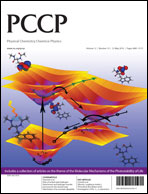Direct spectroscopy of contact charge transfer states: Possible consequences for tryptophan excited-state deactivation pathways by O2 and formation of reactive oxygen species
Abstract
This paper demonstrates that

- This article is part of the themed collection: Molecular mechanisms of the photostability of life

 Please wait while we load your content...
Please wait while we load your content...